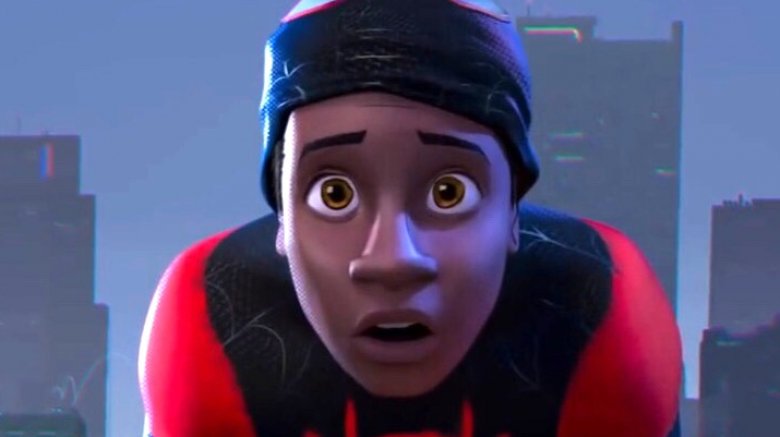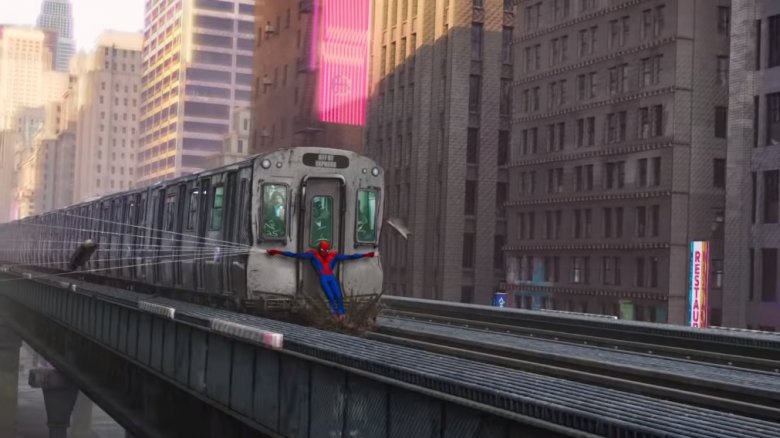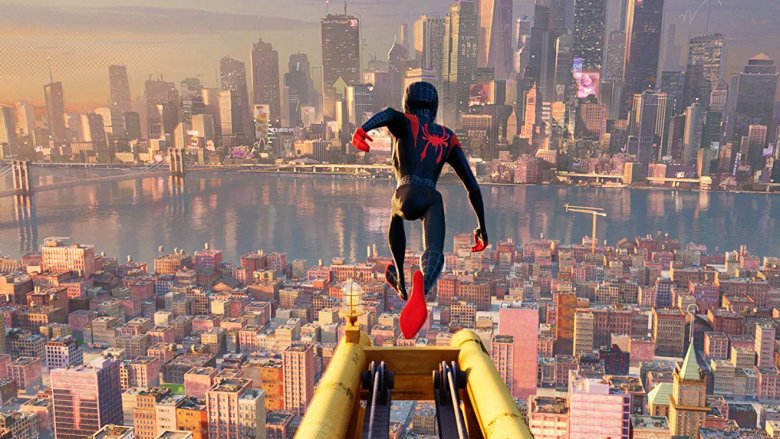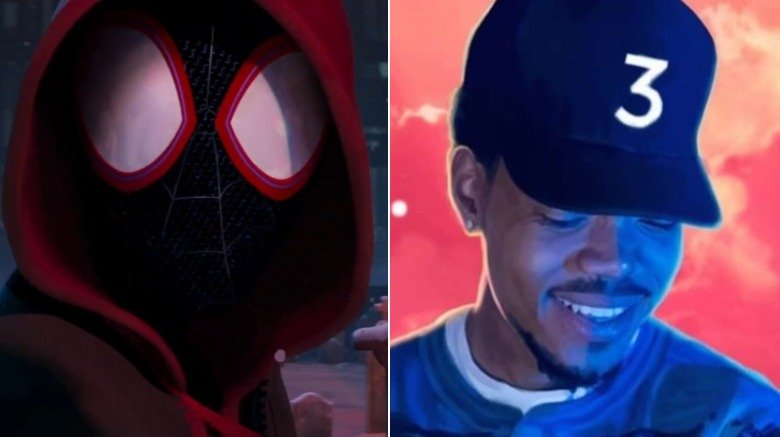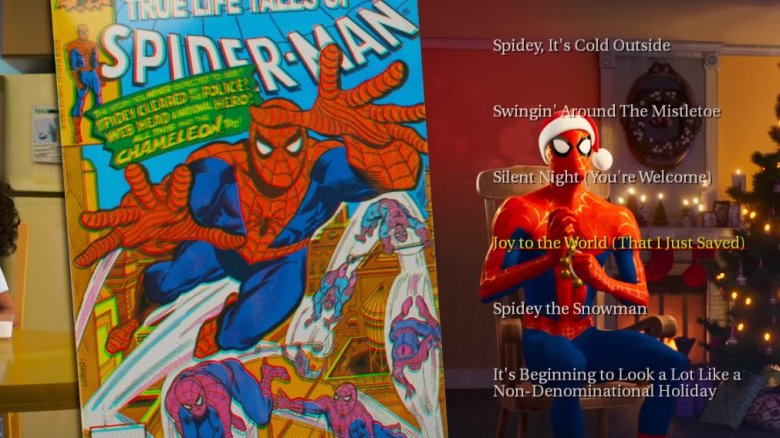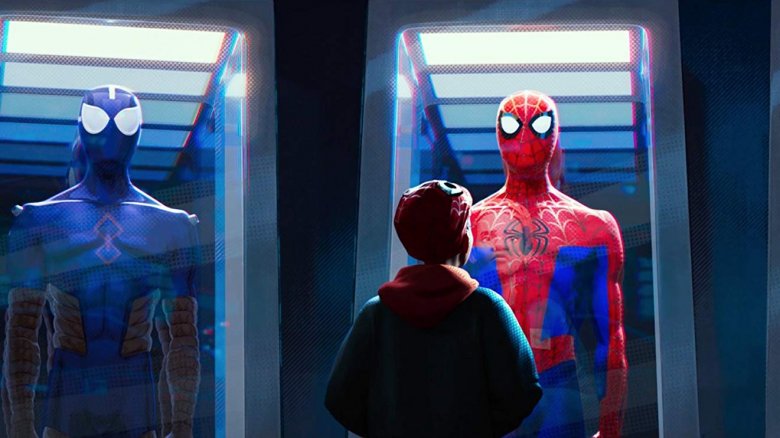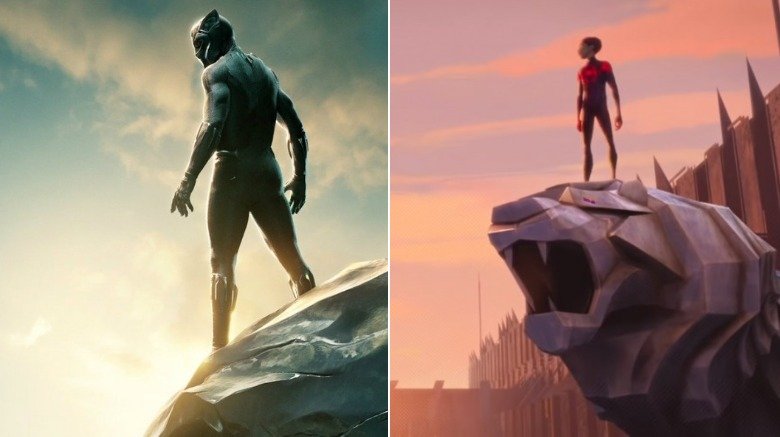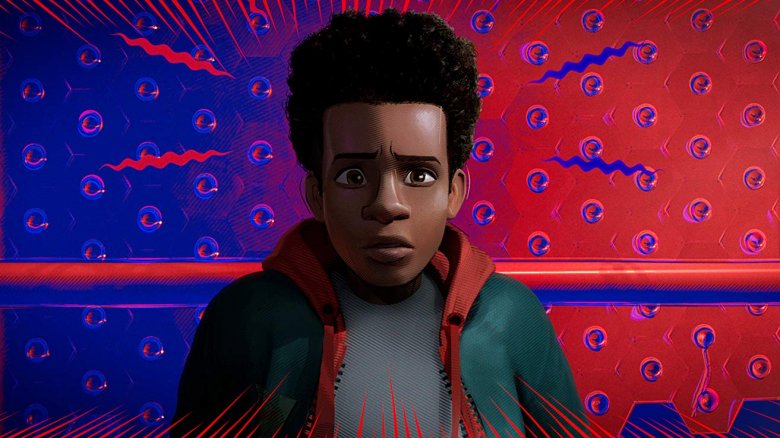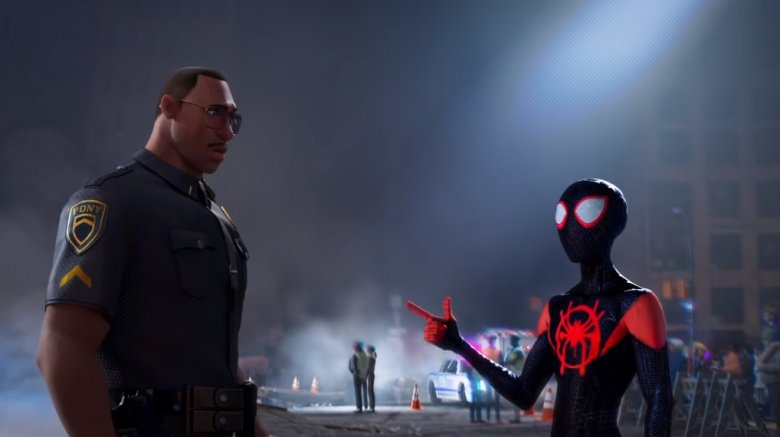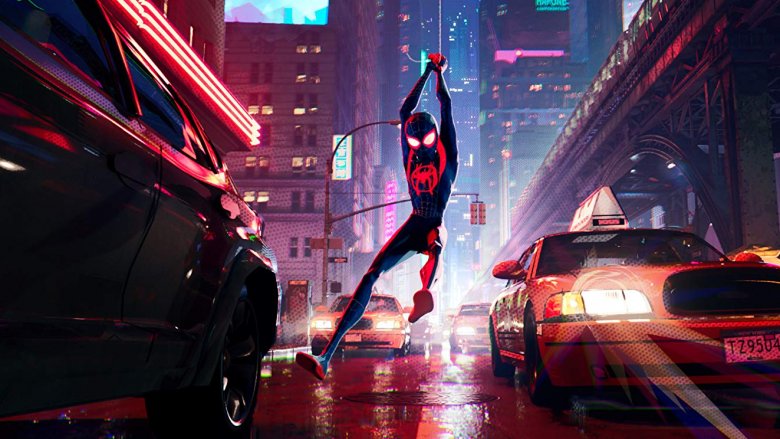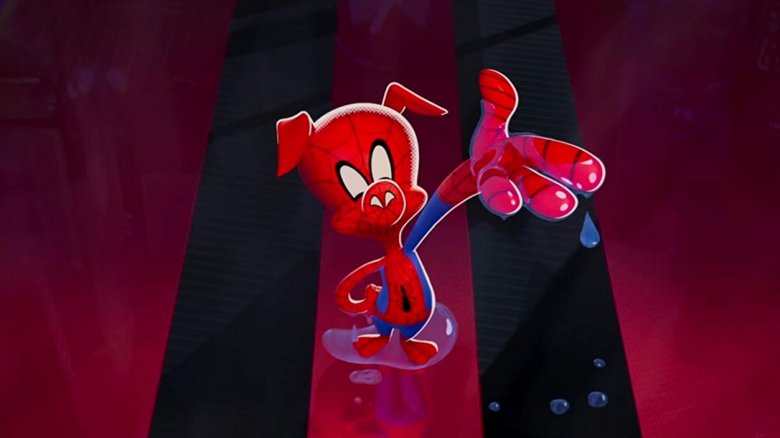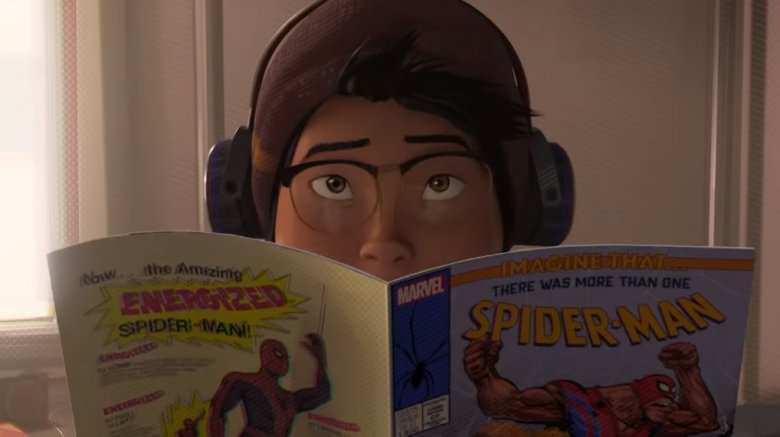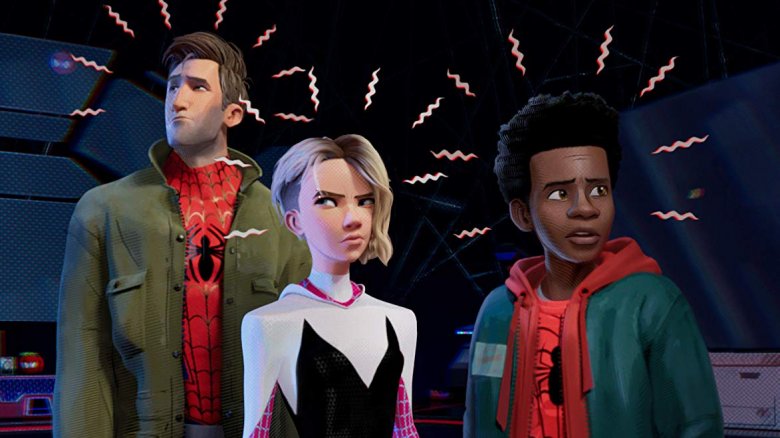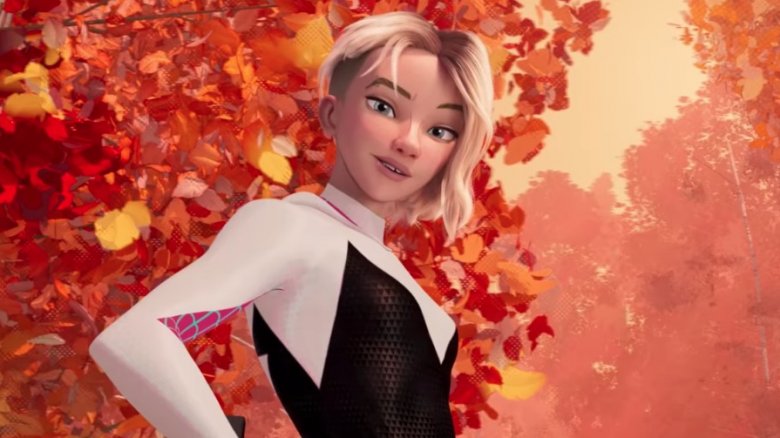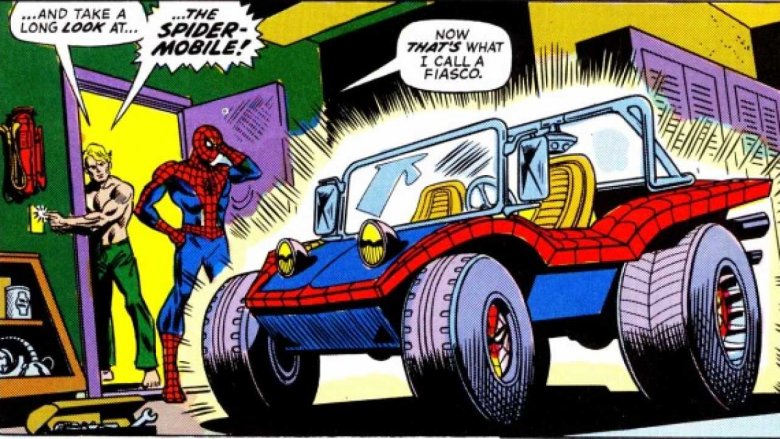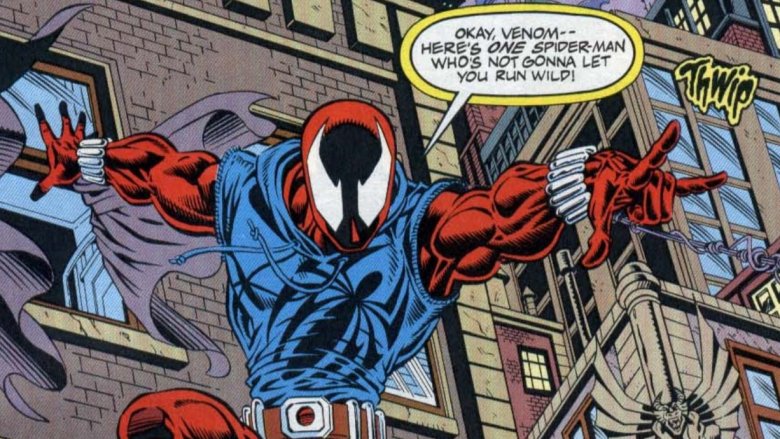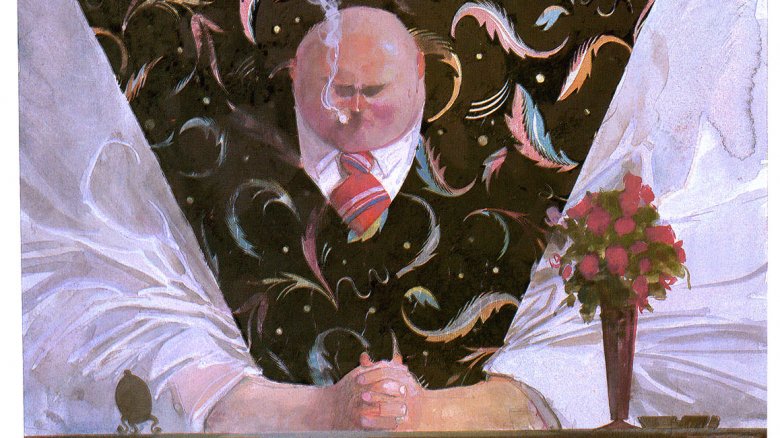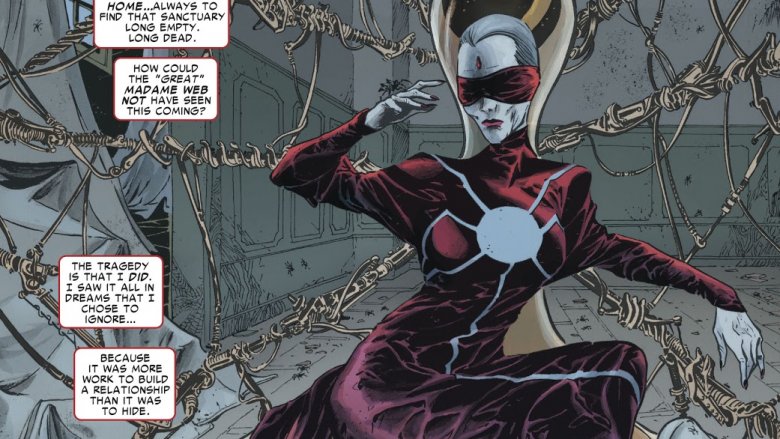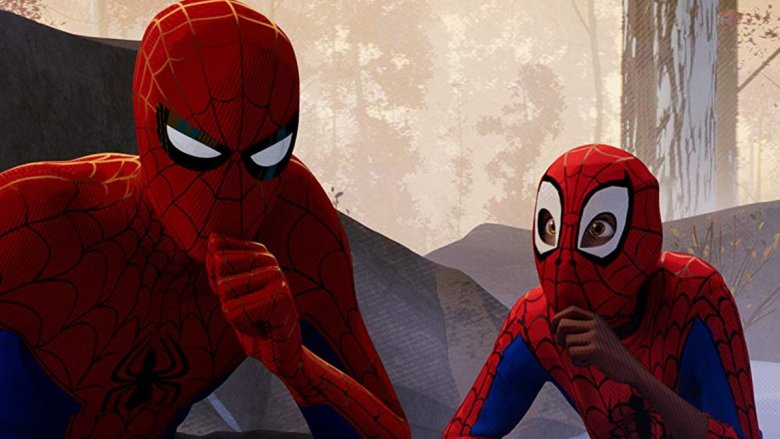Spider-Man: Into The Spider-Verse Easter Eggs You Missed
It's rare to see a movie that's as unabashed of a comic book celebration as Spider-Man: Into the Spider-Verse. The Sony Pictures Animation release, which loosely adapts the Marvel Comics "Spider-Verse" storyline from 2014, has debuted to almost universal critical acclaim, offering wit and kinetic web-slinging action for general audiences and comics enthusiasts alike.
For fans of the Spider-Man sector of Marvel Comics, Into the Spider-Verse is a gorgeous smorgasbord of references and inside jokes, making for a remarkably fun viewing experience as the movie serves up little bits of Spider-trivia to stoke the viewer's memory. (It also has what is perhaps the most bittersweet and heartwarming Stan Lee cameo we're ever going to see — but we're sure you caught that one.)
If you're even slightly a fan of Spider-Man, you're in for a treat with this movie, because there's enough hidden away inside of Spider-Verse to keep surprising viewers on their second, third, or even fourth run-throughs. Here are just a few of the Easter eggs you might have missed in Spider-Man: Into the Spider-Verse.
Revisiting history
While Spider-Man: Into the Spider-Verse is ultimately an origin story for Miles Morales, it shares its spotlight with a number of other Spider-People in the process. The first hero audiences are introduced to is the Peter Parker of Miles' universe, a paragon of goodness, decency, and hyper-capable heroism. The movie starts off with this Peter's narration, catching viewers up on the broad strokes of the Spider-Man story.
Now would be a good time to mention one great thing about living in this golden age of comic book movies — finally, the people behind these movies realize that we all already know Spider-Man's origin story. All of us. Every single person. For that reason, Spider-Verse spends less time belaboring the point and more time building in some cheeky references to past Spider-Man adventures — specifically, the Sam Raimi-directed trilogy of Spider-Man movies.
During Peter's recounting of his exploits as a superhero, the movie revisits several classic set pieces from the Raimi movies, including Spider-Man's heroic train rescue from Spider-Man 2, the time Doctor Octopus threw a car through a window at Peter Parker and Mary Jane in Spider-Man 2, and the much-derided (but secretly awesome) sequence of a symbiote-influenced Peter strutting around New York City in Spider-Man 3 shooting everyone some finger guns.
Creative contacts
Everyone knows that Marvel loves its Stan Lee cameos. But while that tradition of honoring the influential Marvel Comics creator has provided bright spots in even the worst of Marvel movies, it's less common to see shoutouts to other important artists from the company's history. After all, these characters and their many, many stories weren't created single-handedly.
Spider-Man: Into the Spider-Verse provides a bit of a call-out for two other figures who were crucial to Spider-Man's development, with the names of at least two writers and artists visible in the contacts on both Miles' cell phone, and his father Jefferson's.
When Miles is on the train shortly after discovering his powers, he pulls out his phone and scrolls through the contacts rapidly, passing by a conspicuous entry for "B Bendis" — a reference to Brian Michael Bendis, who co-created Miles with artist Sara Pichelli in 2011. Later, in a similar moment with Jefferson, Jeff scrolls by an entry for Steve Ditko, who co-created the first Spider-Man with Stan Lee in 1962.
(Comic) Coloring Book
One of the most fun aspects of Spider-Man: Into the Spider-Verse is just how easy it is to identify yourself with Miles Morales; you don't need to have grown up with his background to sympathize with his experiences. His introduction in Spider-Verse, procrastinating at home on a morning before school while half-singing, half-humming Post Malone and Swae Lee's "Sunflower," is as strong a start as any, grounding this kid in a reality we can relate to.
Though Miles is Brooklyn born and raised, he also seems to be a fan of the Chicago-based independent MC Chance the Rapper, with a poster for his mixtape Coloring Book appearing in the background of several shots in Miles' room. Amusingly, the distinctive baseball cap Chance wears on the real-life cover, with a number 3 on it indicating that the mixtape is his third release, has been changed in Miles' alternate universe to the number 4, implying that the Chance of his universe is slightly more prolific than the version that we know. (Maybe Miles' universe just put a lot more emphasis on the Lil B collab.)
Rockin' Around the Spider's Web
The best part about the humor of Spider-Man: Into the Spider-Verse is that it lets the viewers in on the joke. We all know that Spider-Man is more than just a character — he's a lucrative multi-media property that gets licensed out to everything from toys to lunch boxes and everything in between, all in the pursuit of a buck or two for corporations that often couldn't care less about quality. (For examples, look to the expectation-whiffing Spider-Man Popsicle, which this movie itself also spoofs, or uh, Sony's own Amazing Spider-Man 2.)
Part of Peter Parker's intro to the movie focuses on the extensive library of Spider-Merch that's been created over the course of the webslinger's crimefighting career, with one of the most amusing products being the Spider-Man Christmas album. But this isn't a joke that was made for the movie — it's actually a joke from real life.
The album in the movie is a reference to a real Spider-Man album that was released in 1975, a rock opera from the label Lifesong Records called Spider-Man: Rock Reflections of a Hero. It is awesome. Imagine a middling Jefferson Airplane album with lyrics about how no one's got a crush on Peter Parker, sung to jaunty melodies that'll get stuck in your head all day. In some alternate universe, this thing is a chart-topping hit.
Choose your costume
There have been so many Spider-Man suit designs over the years at this point that you could spend days putting together a list of your favorite looks. (We've always been fond of the Scarlet Spider, with Spider-Gwen's look also striking us as something of an instant classic.) Spider-Man: Into the Spider-Verse offers up an embarrassment of riches in the fun suit department, especially inside of Aunt May's surprising secret Spider-Lair.
Several of the suits visible in the background of the high-tech Spider-Cave (or whatever you want to call it) are culled from Spidey's long comic book history, and also show up in the Spider-Man PS4 game — particularly the advanced suit with the white logo. You can also spot looks reminiscent of the black-and-green stealth "Big Time" suit, the Electro-Proof suit, the black suit from "Secret War," and even a look similar to the black Dusk suit.
The most humorous suit, which features a seemingly inconvenient superhero cape, also has precedent in the comics, according to Screen Rant. That suit, which Miles briefly interacts with, is similar to one which originally appeared in Marvel Comics' What If? #19, published in 1980.
Imitation is flattery
One of the more left-field references in Spider-Man: Into the Spider-Verse is tempting to chalk up to coincidence — but it really doesn't look like it. At separate points in the movie, both the Peter Parker Spider-Man and Miles Morales take a respite from their crimefighting on the head of a panther-esque gargoyle jutting off the side of some New York City architecture. Peter has some coffee and reads the newspaper, while Miles strikes a pose highly reminiscent of another superhero: T'Challa himself, the Black Panther.
The movie features imagery that originally appeared on a poster for the Black Panther movie released during the 2017 San Diego Comic-Con. In that image, T'Challa can be seen in his full Black Panther suit, looking out over the horizon under soft lighting as he flexes his glutes for the camera. It's a slightly unexpected reference, considering that Black Panther and Spider-Verse are made by totally different studios, with Spider-Verse being strictly a Sony Pictures joint. Who knows? Maybe Miles' dimension has a Marvel Cinematic Universe all its own.
This colorful world
For our money, you'd be hard-pressed to find a prettier animated movie to see release in 2018 than Spider-Man: Into the Spider-Verse. Outside of some of the action sequences, which can get a little bit busy, every frame of the movie feels like a distinct work of art, lovingly rendered to maximize the feeling of watching a comic book in motion. It's something other movies have tried before, but rarely has it been done so vibrantly.
A part of the process for creating this distinctive comic book look is the use of Ben-Day dots to colorize the picture. This process, popular in early comic books, creates color tones through the use of small dots of different colors, sometimes overlapping with each other to create new shades. It's something that's present in Spider-Verse from its opening title cards, and does a lot of work to give the movie that distinctive comic book feel.
Law and order
Jefferson Davis, Miles Morales' police officer father, presents himself as a good guy who emphasizes law and order. So what better way to indicate his allegiances than with a reference to the TV franchise Law and Order?
In the beginning of Spider-Man: Into the Spider-Verse, Miles gets a ride to the Visions boarding school on his first day from Jefferson, driving his police car. The license plate for Jefferson's car (a PDNY vehicle, as opposed to an NYPD vehicle, because alternate universe) is clearly visible as RFD 960. You probably didn't notice, what with the cringe-worthy scene of Jefferson completely owning his kid in public with some ultimate father "tell me you love me" business. Even if you did notice, it's hard to divine what exactly the plate could be a nod to in the first place. This is no comic book reference, though. As a matter of fact, it's a reference to the detectives' vehicle in the original Law and Order series, which bore the same license plate through that series' entire run. Dun-dun.
Hello There, Times Square
Just like in real life, there's a lot going on in Spider-Verse's Time Square. Tons of lit-up and animated billboards vie for the viewer's attention every time we visit the area, and a few of them are cute references for the audience. One image is a nearly-perfect recreation of the poster for the Edgar Wright movie Shaun of the Dead, this time titled cleverly as From Dusk Till Shaun. Whether it's meant to be a sequel to that movie or just an alternate universe title, it's a fun thing to notice if you're a zombie-loving horror nerd.
Another billboard is an advertisement for a Broadway show called Hi, Hello, which is a much more relevant reference to some other work from a member of the movie's cast. The advertisement is clearly aping the real-life show Oh, Hello on Broadway, which starred comedians Nick Kroll and John Mulaney. Mulaney, of course, is a part of the Spider-Verse movie as the voice of Peter Porker, the spectacular Spider-Ham. Sadly cancelled MTV show Clone High (created by Into The Spider-Verse writer Phil Lord and producer Chris Miller) looks to have gotten a sequel with advertisements for Clone College in the background of Times Square. Meanwhile, Bridesmaids also seems to have spawned a franchise with Baby Showers. Seth Rogen is back with a cowboy movie called Hold Your Horses, the Blue Man Group have gone Red, and Blake Griffin has turned to baseball instead of basketball. There are no doubt even more background jokes just waiting for you to catch once the film arrives on Blu-ray and streaming services. If nothing else, it certainly makes Times Square look like more fun to hang out in.
Copyright warning
While he's far from the main character of the movie, Peter Porker gets his fair share of moments to shine over the course of the Spider-Verse adventure. Whether he's wheeling his little legs like he's straight out of a Looney Tunes short, or pulling anvils and hammers out of the air like he's an Acme spokesperson, this diminutive hero does a lot to remind the viewer that oh yeah, I'm watching a cartoon.
As Porker is preparing to leave Miles' dimension after the supercollider portal is opened, he bids a fond farewell to his new Spider-friends with a bittersweet "That's all, folks." This declaration, obviously a reference to Porky Pig's classic Looney Tunes signoff, is met with an offscreen comment from Peter B. Parker, who wonders aloud if it's even legal for him to say that. This fourth-wall breaking moment refers to the fact that the Looney Tunes, much like the rival DC Comics movies, are a Warner Brothers property.
Imagine that
Shortly after all of the Spider-people converge, they meet for a pep talk inside of Miles' boarding school dorm room, which he shares with a roommate. When the roommate returns and catches them unawares, they all dart up to the ceiling, shuffling around the corners to avoid being seen while the roommate reads from a comic book. It doesn't work, but when the roommate notices the Spider-swarm, viewers can also notice that the comic book he's reading conveniently refers to a story called "Imagine That... There was more than one Spider-Man." Imagine that, indeed.
While Marvel Comics never published a line of comics by the title of "Imagine That," they do publish a series called What If. This speculative line of comics, published since 1977, usually focuses on one-off larks that could never sustain a serial story on their own, allowing writers and readers to explore weird hypothetical scenarios for their favorite characters, such as "What If Spider-Man had joined the Fantastic Four?"
Pointed reference
If you didn't stick around for the very end of Spider-Man: Into the Spider-Verse, then we don't know what to tell you. Have you seen a comic book movie before? You're not supposed to leave until security shows up.
The post-credits scene for Spider-Verse thrillingly introduces one of the best and coolest Spider-People: Miguel O'Hara, a.k.a. Spider-Man 2099. (It also introduces his digitized personal assistant Lyla.)
At first, it seems as though this stinger will be setting up a far-ranging Spider-Verse sequel, but that notion quickly sails out the window when Miguel travels to the goofy alternate universe of Earth-67. In Marvel Comics canon, this world is the home of the 1967 Spider-Man cartoon, a cornball program with crude animation. When Miguel arrives, he immediately begins doing a bit with '67 Spider-Man, recreating the "Spider-Man pointing at Spider-Man" meme for what feels like a hilarious full minute. And then the movie ends. It's arguably the craziest, weirdest, funniest post-credits scene in a genre that is full of them, and the perfect way to send off this love letter of a movie.
Even more creator shout-outs
Bendis, Pichelli, and Ditko aren't the only comics creators to get a shout-out in Into The Spider-Verse. One of the other contacts in Miles' phone is D. Slott — referencing comic book writer Dan Slott, the writer who coined the term Spider-Verse during a crossover that brought together dozens of interdimensional spider-folk to save the world (naturally).
Meanwhile, Miles walks past a ramen shop called "Romita Ramen" partway through the film. This is likely a double shout-out; John Romita Sr. was the artist who took over the art duties on Amazing Spider-Man after Ditko left the title, and is best known for making Peter Parker into much more of a handsome guy than Ditko's original conception. He's also the co-creator of Mary Jane Watson, who appears in the film, and the original version of The Prowler — the Prowler featured in the film is Aaron Davis, the Ultimate Prowler who was created by Bendis and Pichelli. His son, John Romita Jr., likewise had a long, successful run on Amazing Spider-Man.
Finally, when Gwen Stacy's Spider-Woman appears, the cover of her comic makes sure to credit her actual creators: Jason Latour, Robbi Rodriguez, and Rico Renzi. It goes further than just a shout-out, too: Gwen's flashback sequences are washed over in kinetic neon pinks and purples, a perfect replication of colorist Rico Renzi's color scheme in the Spider-Gwen comic.
Does whatever a spider-car can
When the various Spider-people arrive at Aunt May's house, they're treated to a surprising sight: a massive, hidden underground base with just about everything a friendly neighborhood Spider-Man could need. It's a bit like the Batcave, complete with glass cases full of Spider-Suits and even a Spider-car. If you thought that was just a fun nod to the Distinguished Competition's most brooding billionaire, it's actually a canny reference to a spider-branded car that Spidey briefly drove around New York in the comics.
The Spider-Mobile could drive along walls, shoot webbing, and even had Spider-Man branded wheels. As you might expect for a superhero that already has a visually distinct way of getting around New York, the Spider-Mobile didn't last long in the comics. It was quickly thrashed, lost, and repurposed by a supervillain to try and kill Spider-Man (of course). However, it's continued to make occasional appearances in Marvel Comics in the intervening decades, just not as Spidey's main mode of transport.
Aunt May and Olivia Octavius
One of the subtlest Easter eggs in the film comes when Aunt May reacts to Olivia Octavius with a resigned "Liv" as the mad scientist invades her home. As she told Spider-Man earlier in the film, her enemies call her Doc Ock, but her friends call her "Liv." The fact that Aunt May knows, and uses, Doc Ock's nickname hints at a previous relationship between the two. But what did that relationship look like?
Well, if Miles' universe is anything like the 616 universe, chances are that Doc Ock and Aunt May almost got married. It all happened in Amazing Spider-Man #131, which featured the octopedal menace nearly marrying Spidey's aunt in order to claim a nuclear power plant that May received from a recent inheritance. As it turns out, though, later retcons would clarify that Otto wasn't just marrying Aunt May for the inheritance; the mad doctor actually developed some feelings for her. Whatever the relationship is between Aunt May and Liv in Into the Spider-Verse, we wouldn't expect a reconciliation anytime soon, since Doc Ock is at least somewhat responsible for Peter's death.
Ben Reilly, Spider-Man at last
Speaking of Aunt May's favorite nephew, fans were no doubt surprised to see Peter Parker (voiced by Chris Pine) bite the bullet early on in the film. It's consistent with the Ultimate Comics origin for Miles, but there's another comics reference buried in that early scene. When Peter takes off his mask, his hair is blond instead of the expected brown. That's because the filmmakers are paying homage to the original duplicate Spider-Man, Ben Reilly. In the comics, Reilly was a clone of Peter Parker (who was briefly "revealed" to be the original Parker before a later retcon established that that was a trick) who dyed his hair and changed his name to differentiate himself from his clone. He even went by a new codename: Scarlet Spider.
Still, don't expect the blond hair to be a clue that this version of Peter Parker is actually alive. It's much more likely just a winking nod to one of the most infamous Spider-Man storylines ever made.
Plenty of love for Glover
While Shameik Moore (The Get Down, Dope) does an excellent job voicing young Miles Morales in the film, many fans had their hearts set on Donald Glover to portray the young web-slinger. The Atlanta creator was pushed into the Spider-spotlight when he half-jokingly campaigned to play the role of Spider-Man in 2010. While the role ultimately went to Andrew Garfield, Glover did voice Miles Morales in the Ultimate Spider-Man cartoon, and he even appeared in Spider-Man: Homecoming as Aaron Davis. Aaron also appears in Into the Spider-Verse (voiced by Mahershala Ali), and the filmmakers found time to acknowledge Glover's various roles in a quick Easter egg.
When Miles goes to visit Aaron, eagle-eyed fans can spot Aaron watching a few seconds of Community. Specifically, "Anthropology 101," an episode that features Glover's Troy Barnes waking up in Spider-Man pajamas as a tribute to the fan campaign to cast him as Spider-Man.
Art for art's sake
Into the Spider-Verse might just be one of the best-looking films of the year, and the film is also absolutely loaded with constant visual references to classic comic arcs and character designs. Kingpin (Liev Schreiber) dominates the screen whenever he's shown, in an obvious reference to Bill Sienkiewicz's famous portrayal. Meanwhile, his super-collider shoots out "Kirby Krackle," the immediately recognizable comic effect used by artist Jack Kirby in hundreds of comic book issues.
The famous cover to Amazing Fantasy #15 (the first appearance of Spider-Man) gets multiple references in the film, both as the cover to a comic and when Peter Parker saves Miles early in the film. It's not just the original comics that get shoutouts in the film — even well-known Spider-Man memes get referenced. When Peter and Miles infiltrate Alchemax, there's a shot of Spider-Man sitting behind a computer desk, echoing one of the most famous Spidey memes ever made.
Madame Web
Aunt May's role in the film is a lot closer to Batman's faithful butler Alfred then the worried old woman that most fans are familiar with. In fact, she seems to have been a pretty important part of Spider-Man's whole operation, enough that she probably would have warranted her own codename.
If she did get a nickname in the film, chances are it would've been Madame Web. In the comics, Madame Web is an older woman with a bandage over her eyes who advises Peter (as well as other spider-people) about upcoming disasters and various other calamities. She's often pictured sitting against a chair in a pose suspiciously similar to one that Aunt May takes while showing the spider-folk around the Spider Cave. Still, considering that May isn't blind or clairvoyant (as far as we know), it's more likely a sneaky visual reference than actual confirmation of yet another Spider-themed hero hidden in the film.
Spider-Man, Spider-Dad
Throughout Into The Spider-Verse, Peter B. Parker struggles with the mess he's made of his life. He's sleepwalking through his days and eating pizza in the shower. It's pretty grim. Part of that descent into unpleasant hedonism is his divorce from Mary Jane, for reasons that aren't explicitly revealed in the film. However, if you pay attention to some of his lines, it becomes readily apparent just why the two of them broke up: he didn't want kids.
It's once again a storyline slightly adjusted from the comic book source material. In the '90s, Peter and MJ almost had a baby before separating for a few years. In the movie, it seems like Peter's been living in a state of arrested development, unwilling to actually grow up. However, by the end of the film, teaching Miles has been so life-changing that he even takes a moment during the final battle with Kingpin to wonder if he actually does want kids. In one comics timeline, he eventually does have a daughter with MJ, May Parker, who naturally grows up to be Spider-Girl. If Peter and MJ do get back together following the events of Spider-Verse, we wouldn't be surprised to see May Parker pop up in the sequel (or even in the upcoming Gwen Stacy Spider-Woman spinoff).
